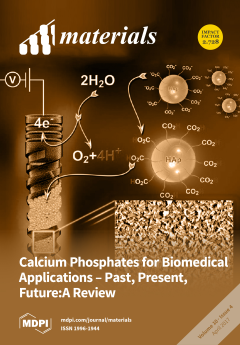In this paper, the microstructure, the room-temperature and high-temperature tensile mechanical properties of monolithic TA15 alloy and TiB whisker-reinforced TA15 titanium matrix composites (TiBw/TA15) fabricated by vacuum hot-pressing sintering were investigated. The microstructure results showed that there were no obvious differences in the
[...] Read more.
In this paper, the microstructure, the room-temperature and high-temperature tensile mechanical properties of monolithic TA15 alloy and TiB whisker-reinforced TA15 titanium matrix composites (TiBw/TA15) fabricated by vacuum hot-pressing sintering were investigated. The microstructure results showed that there were no obvious differences in the microstructure between monolithic TA15 alloy and TiBw/TA15 composites, except whether or not the grain boundaries contained TiBw. After sintering, the matrix microstructure presented a typical Widmanstätten structure and the size of primary
β grain was consistent with the size of spherical TA15 titanium metallic powders. This result demonstrated that TiBw was not the only factor limiting grain coarsening of the primary
β grain. Moreover, the grain coarsening of
α colonies was obvious, and high-angle grain boundaries (HAGBs) were distributed within the primary
β grain. In addition, TiBw played an important role in the microstructure evolution. In the composites, TiBw were randomly distributed in the matrix and surrounded by a large number of low-angle grain boundaries (LAGBs). Globularization of
α phase occurred prior, near the TiBw region, because TiBw provided the nucleation site for the equiaxed
α phase. The room-temperature and high-temperature tensile results showed that TiBw distributed at the primary
β grain boundaries can strengthen the grain boundary, but reduce the connectivity of the matrix. Therefore, compared to the monolithic TA15 alloy fabricated by the same process, the tensile strength of the composites increased, and the tensile elongation decreased. Moreover, with the addition of TiBw, the fracture mechanism was changed to a mixture of brittle fracture and ductile failure (composites) from ductile failure (monolithic TA15 alloy). The fracture surfaces of TiBw/TA15 composites were the grain boundaries of the primary
β grain where the majority of TiB whiskers distributed, i.e., the surfaces of the spherical TA15 titanium metallic powders.
Full article






